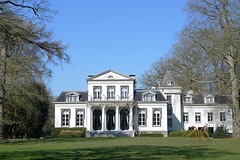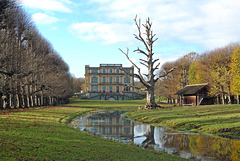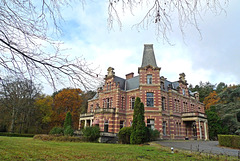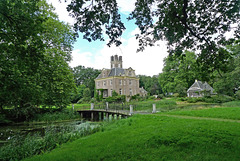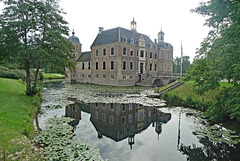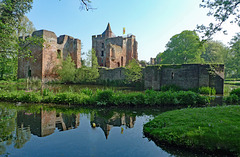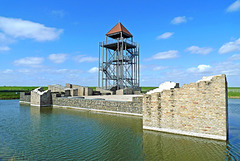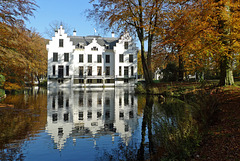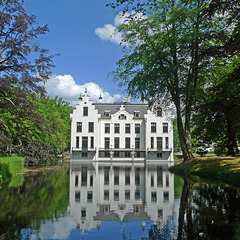
Nederland: kastelen en buitenplaatsen
Folder: Nederland - the Netherlands
Foto's van Nederlandse kastelen, landhuizen, havezathe's en buitenplaatsen.
Nederland - Friesland, Huize Oranjewoud
| |
|
|
|
In 1664 the Frisian Nassau’s bought some heathland east of Heerenveen known as ‘t Wold’. The ‘village’ became its name 'Oranjewoud' ('Orange Forest' – Orange is the colour of the Dutch royal family) in the year of 1676, when Albertina Agnes, Prinses van Oranje Nassau, after the death of her husband Willem Frederik van Nassau - Stadtholder of Frisia - bought an existing country estate.
Early 18th century her daughter-in-law Henriëtte Amalia van Anhalt-Dessau modernized the manor by (landscape) architect Marot (well known for the construction of Palace Het Loo nearby Apeldoorn). Marot designed two new wings for Oranjewoud, but the central building was never built. The architect also planned the gardens and park around the manor. During the French occupation, both wings were demolished and the property was sold. Two estates were built where the Stadtholder's country house had once stood: Oranjewoud at the site of the old castle and Oranjestein where the home of the steward had been.
Various generations of the Oranje-Nassau family spent their summer at Oranjewoud.
White plastered Huize Oranjewoud - built 1834 on the place of the former (royal) Palace Oranjewoud - is surrounded by a beautiful garden and a moat. It is private owned and it can not be visited. Opposite of the house is the entrance to the so called ‘Overtuin’ - see note - a lovely garden/park in English style.
Nederland - Huize Oranjewoud
| |
|
|
|
In 1664 the Frisian Nassau’s bought some heathland east of Heerenveen known as ‘t Wold . The ‘village’ became its name Oranjewoud (Orange Forest - Orange is the colour of the Dutch royal family) in the year of 1676, when Albertina Agnes, Prinses van Oranje Nassau, after the death of her husband Willem Frederik van Nassau - Stadtholder of Frisia - bought an existing country estate.
Early 18th century her daughter-in-law Henriëtte Amalia van Anhalt-Dessau modernized the manor by (landscape) architect Marot (well known for the construction of Palace Het Loo nearby Apeldoorn). Marot designed two new wings for Oranjewoud, but the central building was never built. The architect also planned the gardens and park around the manor. During the French occupation, both wings were demolished and the property was sold.
Two estates were built where the Stadtholder's country house had once stood: Oranjewoud at the site of the old castle and Oranjestein where the home of the estate manager had lived. Various generations of the Oranje-Nassau family spent their summer at Oranjewoud. It remained in the possession of the Oranje-Nassau family for a long time. The last time a family member showed up was in 1791. Not long after, the summer residence was demolished.
In 1823, the jonkheer De Blocq van Scheltinga bought the land and had the current country house built on the old foundations. White plastered Huize Oranjewoud (Country House Oranjewoud) is surrounded by a beautiful garden and a moat. The estate remained in the family until 1953.
Huize Oranjewoud is private owned and is used and rented to companies for meetings of all kinds.
Nederland - Oranjewoud, Huize Oranjestein
| |
|
|
|
Huize Oranjestein (Country House Oranjestein) was built on the site where, around the 18th century, the residence of the estate manager of Landgoed Oranjewoud (Country Estate Oranjewoud) stood. The estate belonged to the Van Nassau-Dietz family.
Oranjestein was bought in 1820 by the merchant Pieter Cats. The property was thoroughly rebuilt by the new owner and was completed two years later. More alterations followed; a final thorough renovation took place in 2008/2009, whereby the house retained its original 19th century atmosphere.
The Oranjestein estate is still privately owned. Access to the estate/park is restricted to a number of Sundays in the summer. Since 2003, the Oranjestein estate is a national Dutch monument.
Nederland - Overveen, Elswout
| |
|
|
|
Dutch economy reached a peak in the Golden Age. To escape the foul stench of the city in the summer, wealthy Amsterdam merchants invested in luxurious country estates with park-like gardens in the forested inner dunes. Thanks to a system of barge-canals and rivers, they could travel from Amsterdam to their estates in just a few hours. The area west of Haarlem (Kennemerland) became the cradle of these country estates.
Buitenplaats (summer residence) Elswout was founded in the middle of the 17th century by Carel du Moulin, but the Amsterdammer Gabriel Marcelis completed the first construction of Elswout. Over the centuries, many great architects worked on the ever-changing architecture.
The oldest buildings on Elswout date from the 17th century. The construction of the Grote Huis (Big House) on the Elswout Estate already started in 1884. When the façades and the terraces were completed, the client Willem Borski jr. died and construction came to a standstill. Although the building was given various functions after his death, it remained unfinished.
After being occupied by the Germans during World War II the building was in bad shape. It later functioned for different purposes like schools. Elswout estate and the house became property of the municipality in 1958 and the Dutch State Forestry Commission in 1970. Over the years they could not find a proper function for the building and decided to have a competition for the rebuilding and renovation of the estates building. A private company decided to take up the challenge. After thorough search and research the original plans from around 1814 were found. Restoring the building’s interior and exterior according to those plans started in 2004 and realizing a new high end office function for the building.
Elswout also offers one of the most beautiful and watery country estates along the inner dune edge of Zuid-Kennemerland National Park. This 85-hectare national monument has a rich plant and animal life and is dotted with several special follies. Because of the special flora and fauna, Elswout (and the rest of National Park Zuid- Kennemerland) have a Natura 2000 status and the area is part of the European protected nature network.
The Elswout house has never been open to the public, so it can only be admired from the outside. The garden can be visited and access is free.
Nederland - Overveen, Duinlust
| |
|
|
|
Duinlust is one of the many so called buitenplaatsen (summer residences) west of the city of Haarlem along the inner dunes. Wealthy merchants from Amsterdam built here their mansions.
In 1783 a first house was built. After it was old in 1810 the new owner founded the Duinlust country estate and built a white house built in Empire style. There was also an orangerie, which still exists. In 1828 the house was sold again to Johanna Jacoba van de Velde, who also was the owner of the nearby Elswout ountry estate . After her death, the country estate goes to her son Willem Borski, a well-known Amsterdam banker. It became the summer residence of his eldest daughter Johanna Jacoba. After Willem Borski's death in 1881, she inherited the estate. Johanna Jacoba had a new house built by architect Constantijn Muysken in 1881. It is designed in neo-renaissance style.
During the World War II, Dutch troops were stationed there, later it was confiscated by the German occupiers. During the last weeks of the war it was used by Canadians and the Homeland Forces. The house was in poor condition and as of November 1, 1947, the government rented the country estate and restored Duinlust.
The CIOS (the first school for sports leaders) was located in the house from 1948 to 2001.
Nowadays the mansion is used for events. The surrounding park is a nature reserve managed by Staatsbosbeheer (a Dutch government organization for forestry and the management of nature reserves).
Nederland - Paterswolde, Huis Vennebroek
| |
|
|
|
Not much is known about the origins of Huis Vennebroek (Manor Vennebroek). From 1689 to 1747 the house had the so-called right of havezate (manor or fortified house). In 1768 the manor was mentioned in an advertisement in a local newspaper. In 1848, Jonkheer Hooft van Iddekinge rebuilt the house extensively, retaining a large part of the basement and the ground floor.
In 1912 the estate was bought by P.A. Camphuis, a merchant from Groningen. He was also the owner of the adjacent Friesche Veen estate; Vennebroek and Friesche Veen have formed a unit ever since. Camphuis restored the house, but did not stay there long. The manor remained in the family for a long time; the wife of his eldest son lived there until her death in 1994.
Around 1985 the house and the estates became the property of Natuurmonumenten (Society for preservation of nature monuments in the Netherlands). Since 2014 the house has been privately owned and inhabited again.
Huis Vennebroek is surrounded by a horseshoe-shaped moat. The estate has many old beeches and chestnuts; the oldest is more than 300 years. In the autumn the estate is known for its many species of mushrooms.
Nederland - Putten, Kasteel Oldenaller
| |
|
|
|
In the Middle Ages the area around Oldenaller was owned by the Van Aller family. In the year of 1494 Reneyr van Aller appears to be the owner of the house. Little is known about the medieval building phases of Kasteel Oldenaller (Castle Oldenaller).
The current almost square castle was built in 1655, commissioned by Johan van Wijnbergen. The manor is entirely built of brick in the style of Dutch classicism. In 1848, Baron Goltstein bought the castle and decided a few years later to carry out important modernisations. A major renovation changes the classicist castle into a romantic, whitewashed exterior. The characteristic central tower replaced a monumental chimney. In these years, the austere, symmetrical park layout also changes into a landscape layout with meandering paths and water features. K.G. Zocher is responsible for these changes to the house and park.
Jonkheer Boreel van Oldenaller was the last noble owner. In 1972, the entire Oldenaller estate was transferred to Natuurmonumenten (Society for Preservation of Nature Monuments in the Netherlands). This preserved the unity of the castle and estate. During a restoration in 1975, the white plaster and a number of 19th century decorations were removed, making the current castle an interesting mix of both construction phases.
Oldenaller estate is relatively unknown, but definitely worth a visit. It is a varied area with streams, forest, farms, wooded banks and agricultural land. The icing on the cake is the stately manor house.
Nederland - Rozendaal, Kasteel Rosendael
| |
|
|
|
Kasteel Rosendael (Rosendael Castle) is mentioned as early as the year of 1314. The castle came into the hands of the counts and later dukes of Gelre. Of the twenty castles in the dukedom, Rosendael was the favourite of many dukes, because of its beautiful location on the edge of the Veluwe moraine.
The large medieval complex originally consisted of an irregular four-sided corps de logis with a circular donjon as its south-west corner tower. In 1722 a square house was built abutting the big tower. The side wing and coach house were built a century later. The round eye-catching donjon is about 19 meters and high and has a diameter of 16 meters. Its walls - up to 4 meters thick - are the thickest in the Netherlands. Although it is the highest tower of its kind in the Netherlands, it was originally twice as high.
After the counts and dukes of Gelre, the castle became the property of drost (state-holder) Willem van Scherpenzeel. After that Kasteel Rosendael came into the hands of various noble families, who occupied it for almost 400 years.
During World War II the castle was hit by an American bomb. It ceased to be a private residence in 1977 when Baron van Pallandt died and the estate was handed over to the foundation Geldersch Landschap en Kasteelen . The castle and garden were fully restored and since 1989 open to the public.
Nederland - Kasteel Ruurlo
| |
|
|
|
The history of Ruurlo Castle (Kasteel Ruurlo or Huis Ruurlo) is dating back to the beginning of the 14th century, when it was first mentioned in the archives as a property of Graaf Reinhoud I van Gelre . The castle was first inhabited bij the family Van Roderlo, after which it is most probably named.
The castle was several times renovated and expanded and shows architecture from five centuries. Its original lay-out is alomost inatct. Its current appearance dates from the 15th and 17th century.
In the 15th century, it passed into the hands of Jacob van Heeckeren, the founder of the noble and distinguished family of Van Heeckeren. Castle and estate were owned and managed by the family for more than five centuries through to 1977. During World War II the castle was used as the headquarters of the German General Staff. In 1977 it passed into the hands of the municipality of Ruurlo and was used as town hall till 2005.
Hans Melchers, a Dutch art collector, bought Castle Ruurlo in 2013. Four years later - after a thorough restoration - it became part of MORE (a museum for Dutch MOdern REalism) with paintings of famous painter Carel Willink and some special creations by the Chinese-Dutch fashion designer Fong Leng.
Nederland - Kasteel Ruurlo
| |
|
|
|
The history of Kasteel Ruurlo or Huis Ruurlo (Ruurlo Castle) is dating back to the beginning of the 14th century, when it was first mentioned in the archives as a property of Graaf Reinhoud I van Gelre . The castle was first inhabited bij the family Van Roderlo, after which it is most probably named.
Kasteel Ruurlo was several times renovated and expanded and shows architecture from five centuries. Its original lay-out is alomost inatct. Its current appearance dates from the 15th and 17th century.
In the 15th century, it passed into the hands of Jacob van Heeckeren, the founder of the noble and distinguished family of Van Heeckeren. Castle and estate were owned and managed by the family for more than five centuries through to 1977. During World War II the castle was used as the headquarters of the German General Staff. In 1977 it passed into the hands of the municipality of Ruurlo and was used as town hall till 2005.
Hans Melchers, a Dutch art collector, bought Kasteel Ruurlo in 2013. Four years later - after a thorough restoration - it became part of MORE (a museum for Dutch MOdern REalism) with paintings of famous painter Carel Willink and some special creations by the Chinese-Dutch fashion designer Fong Leng.
Nederland - Santpoort, Kasteel Brederode
| |
|
|
|
Kasteel Brederode (better known as Ruïne van Brederode ) was founded in the second half of the 13th century by Willem I van Brederode. He was a descendant of the lords Van Teylingen , who were related to the counts of Holland. The castle formed part of the high lordship Brederode, which had been given in loan in the 13th century to the lords of Brederode by the count of Holland.
The name Brederode is a reference to a wooded area called Brede Roede (literally: broad wood), which was cleared and where the castle was built. In its early days the castle was nothing more than a tower. In the year 0f 1300 Dirk II van Brederode had the tower pulled down and replaced it with a more appropriate castle.
The castle remained in the possession of the Brederode family until the year of 1679, when Wolfert , last lord of Brederode, died. The ruins became property of the States of Holland and the Dutch Republic. In the 19th century the ruins were one of the first buildings to be restored by the government and they became the first national monument of the Netherlands.
The ruins can be visted, but have limited opening hours; reason why I couldn’t take more and other pictures.
Nederland - Schin op Geul, Kasteel Schaloen
| |
|
|
|
Castle Schaloen - also named Chaloen - was first mentioned in 1375. It was owned by the knights Johan Struver van Hoelsbergh (or Hulsberg) and Geraerdt Mulaerdt. The last one became the full owner and the castle stayed within his family for the next one and a half century.
During the Eighty Years' War (late 16th century) Schaloen was occupied by Lodewijk van Nassau, but a year later it was destroyed by Spanish troops. The ruined castle came in the hands of Johan Reinier Hoen van Cartiels, who rebuilt it in 1656, using local marl.
Through marriage the castle came in possession of the De Villers Masbourg-family. Famous Dutch architect Pierre Cuypers was in charge of the restoration (1894) of the castle in a neo-Gothic style. The last owner of noble descent, a countess, left the castle in 1934.
The castle has been used as a school, but nowadays it is a private house. The bailey and gate house are housing a restaurant and hotel. The buildings are surrounded by a moat.
Nederland - Schin op Geul, Kasteel Schaloen
| |
|
|
|
Kasteel Schaloen (Castle Schaloen) - also named Chaloen - was first mentioned in 1375. It was owned by the knights Johan Struver van Hoelsbergh (or Hulsberg) and Geraerdt Mulaerdt. The first one became the full owner and the castle stayed within his family for the next one and a half century.
During the Eighty Years' War (1568 - 1648) Schaloen was occupied by Lodewijk van Nassau, but a year later it was destroyed by Spanish troops. The ruined castle came in the hands of Johan Reinier Hoen van Cartiels, who rebuilt it in 1656, using local marl.
Through marriage the castle came in possession of the De Villers Masbourg-family. Famous Dutch architect Pierre Cuypers was in charge of the restoration (1894) of the castle in a neo-Gothic style. The last owner of noble descent, a countess, left the castle in 1934.
The castle has been used as a school, but nowadays it is a private house. The stables and outbuildings are now used as a hotel and restaurant. The castle is surrounded by a moat, which is fed with water from the Molenbeek, a branch of the river Geul.
Nederland – Sint Maarten, Kasteel 't Huys te Nuwen…
| |
|
|
|
Kasteel ‘t Huys te Nuwendore (Castle 't Huys in Nuwendore) was a fortress built by Count Floris V to keep the rebellious West Frisians in check. The castle was built in the 13th century, at the same time as some other castles, among them the Kasteel Radboud in Medemblik. Originally the castle consisted of a residential tower measuring 11 by 11 metres, a main castle measuring 32 by 32 metres and an outer castle.
Kasteel ‘t Huys te Nuwendore was destroyed at the end of the 14th century, probably as a result of a dike breach. The foundations were preserved by the Rijksdienst voor de Monumentenzorg (National Monument Care) in 1960.
Nowadays a watchtower stands on the site of the 13th-century tower. The grounds can now be visited and the tower climbed, which allows a wonderful view of the surrounding landscape.
Nederland - Slochteren, Fraeylemaborg
| |
|
|
|
The Fraeylemaborg originates in the year of 1300 as a strong stone house with thick walls (in the Dutch province of Groningen they were called “borg”). In 1475 there was already a farm with the name “Frealemaheerd”. In the archives of 1504 the name is found of one Remmer Fraeylema.
In the 16th century, the house was expanded and became a moat. From 1670, both wings were added, resulting in a U-shaped building. Through the centuries many powerful families have made the Fraeylemaborg their home. In 1781 the Fraeylemaborg was sold to “Hendrik de Sandra Veldtman”. He rebuilt the Fraeylemaborg into its present shape.
The Thomassen à Thuessink van der Hoop van Slochteren family lived until 1972 in the house. It was sold to the “Gerrit van Houten Stichting”. Nowadays is the Fraeylemaborg a museum, with an interior that illustrates how people lived in a luxury house. The interior consists of precious antiques and everyday personal objects and the collection includes works by the Dutch painter Gerrit van Houten (1866-1934). The museum is combined with a wide range of cultural events and temporary exhibitions.
(During my second visit to the “borg” - second half of December 2018 - the rooms of the Fraeylemaborg were beautifully embellished with Christmas decorations: see PiP’s).
Nederland - Slochteren, Fraeylemaborg
| |
|
|
|
More than seven centuries ago farmers who lived in the neighbourhood needed to protect their crop and themselves and they built a strong stone house (in the Dutch province of Groningen they were called ‘borg’). They were inspired by local monks who started building their monasteries with bricks. Besides churches, these structures were the only buildings that used durable stone and masonry.
In 1475 there was already a farm with the name Frealemaheerd. Times were turbulent and unsafe in this part of the country. The ‘borg’ had to be fortified with a moat and extra walls. About 150 years later the house received its current name ‘Fraeylemaborg’, when it became permanently inhabited by the Fraeylema family.
Through the centuries many powerful families have made the Fraeylemaborg their home. One of them, Hendrik de Sandra de Veldtman, bought the estate in 1781 after decades of neglect and decay. He restored and transformed the house to its present form. In 1972 the last private family left the Fraeylemaborg and the estate was bought by a foundation and opened the park to the public and converted the house to a museum.
The moated ‘Fraeylemaborg’ is surrounded by a beautiful country estate of over 26 hectares with a fragment of a late 17th century garden and a 19th century landscape park. During spring it offers numerous so called ‘stinsenplanten’, plants which are more or less unique for this kind of manor gardens.
Nederland - Kasteel Staverden
| |
|
|
|
Kasteel Staverden/Castle Staverden, also called 'Peacock Castle', because of the white peacocks which were (and still are) kept here.
The present building was built in 1905; the first castle on this spot dates back to the year of 1298. In that year one of the Dukes of Gelre became the city rights for Staverden, nowadays - with only 40 inhabitants - most probably the smallest city on earth.
Nederland - Staverden
| |
|
|
|
Kasteel en landgoed Staverden (Staverden Castle and estate) have a long history. The counts of Gelderland (later dukes) probably already had a court in Staverden in the 12th century. In 1299, Count Reinald I obtained city rights from the German king Rudolph. But it never came to a real city development. Research has shown that Staverden was probably never meant to become a real city. Staverden Estate however does have 16 farms, spread across its lands; a coach house, orangery, watermill, dovecot, workers' houses, a church and a cemetery. It is officially the smallest city in the Netherlands and most probably in the world with its ca. 30 inhabitants (situation 2018).
The castle was frequently used as a hunting lodge by the Dukes of Gelre. Since 1400 there were feudal lords living at castle Staverden, who had to preserve and defend the castle. They also were charged with the duty of keeping white peacocks. The peacock feathers were used to adorn the duke's tournament helmet. There are still white peacocks on the grounds, the castle has a wind vane in the shape of a white peacock and in the surrounding garden one can find a statue of a peacock (PiP 5). Kasteel Staverden (Castle Staverden) is also called Witte Pauwenburcht (White Peacock Castle).
Around 1600 the castle was owned by the Van Haersoltes , who rebuilt it into a more habitable house. Around 1840 the manor was rebuilt again; Staverden Castle got its current form between 1853 and 1905, after the estate was purchased by Frederik Bernard s’Jacob , former mayor of Rotterdam. His heirs sold the house to the current owner, the foundation Geldersch Landschap en Kasteelen .
Jump to top
RSS feed- Latest items - Subscribe to the latest items added to this album
- ipernity © 2007-2024
- Help & Contact
|
Club news
|
About ipernity
|
History |
ipernity Club & Prices |
Guide of good conduct
Donate | Group guidelines | Privacy policy | Terms of use | Statutes | In memoria -
Facebook
Twitter


